New hotels were built across the United States after World War I to meet the increased expectations of a traveling public. Over a dozen hotels were built in Virginia during the Roaring Twenties. Several Old Dominion hotels are highlighted here. These hotels were the center of their city, hosting high school proms, weddings, and civic organization meetings. Their restaurant was often renowned as the city’s best. When a hotel closed its doors, it often caused the decline of the downtown business district. Some of these Virginia hotels are still in operation today, some have been converted to other uses, and some have sadly met the wrecking ball.
Today, all hotels look alike. You can’t tell a Holiday Inn Express from a Comfort Inn, a Days Inn, or a Hampton Inn. Most are clustered around an interstate highway exit and are not part of their community. Coming from the same cookie cutter, modern hotels lack an individual identity unlike the hotels of the early Twentieth Century.
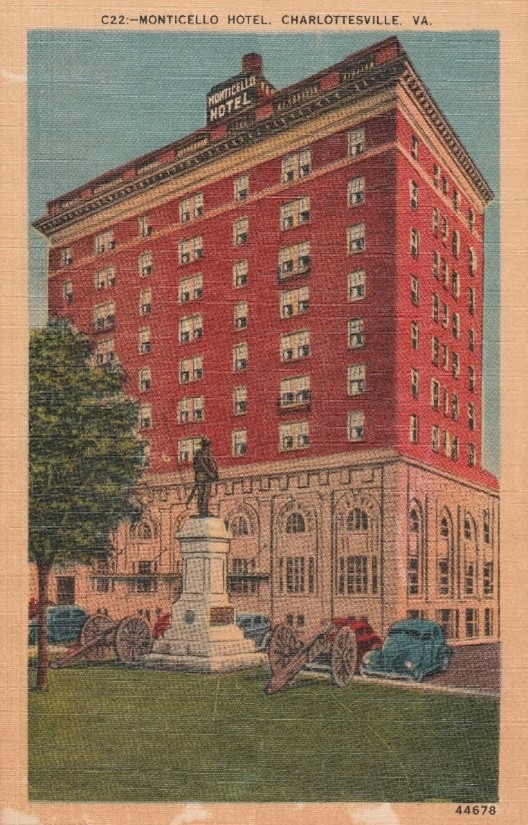
Named for Thomas Jefferson’s mountaintop mansion, the Hotel Monticello in downtown Charlottesville opened in 1926. It had 132 rooms with private baths that offered circulating ice water and radios.
The Monticello was twelve stories tall and built in the Colonial-Revival style, it was Charlottesville’s first skyscraper (it is the second tallest building in Charlottesville today). The glamourous lobby proclaims the Monticello as a luxury hotel. Built on the highest point in Charlottesville, a large searchlight was mounted on the Monticello’s roof that was reportedly visible for 300 miles. In 1973, it was converted to the Monticello Plaza Condominiums and later renamed as 500 Court Square.
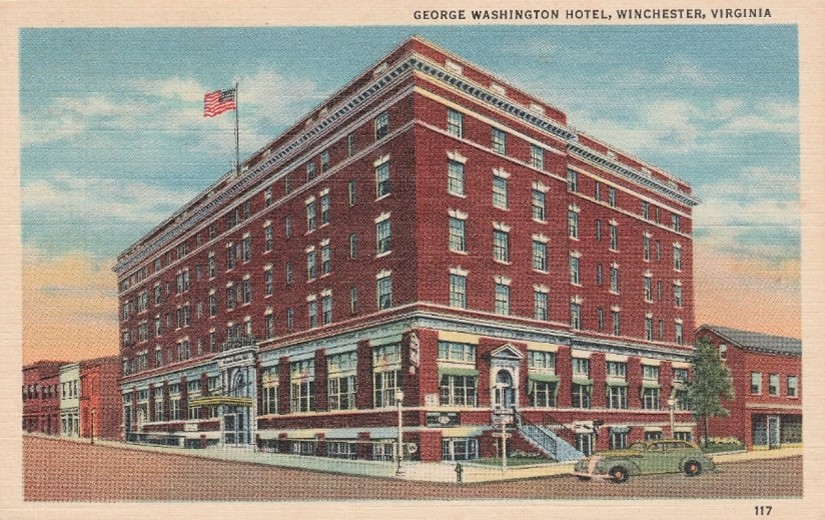
The George Washington Hotel in Winchester, Virginia opened in 1924. Constructed by the American Hotels Corporation as part of its Colonial Hotel chain that included more than 40 hotels in the United States, the Caribbean, and South America.
Located in downtown Winchester at the corner of East Piccadilly and North Cameron streets, it was one block from the B & O Railroad Station. Five stories tall plus a basement, it was the tallest building in Winchester at its completion. It was also located within blocks of U.S. Routes 7, 11, 17, and 50 where they pass through Winchester.
When the George Washington was completed, it had 102 rooms but only 45 bathrooms. A 1929 addition added 50 more rooms. The hotel included a cafeteria, barbershop, candy shop, and men’s clothing store. In 1950, Howard Johnson’s opened a restaurant in the hotel.
The George Washington closed in 1978. I-81 contributed to the hotel’s decline as traffic was diverted away from the city and auto travelers sought lodging adjacent to a highway exit. From 1978 through 1991, an assisted living facility operated in the George Washington. The hotel was then vacant for over a decade. In 2008, after a four-year renovation, the George Washinton reopened and is now affiliated with Wyndham Hotels. The new facility has 90 rooms, a ballroom, restaurant, spa, and an indoor swimming pool.
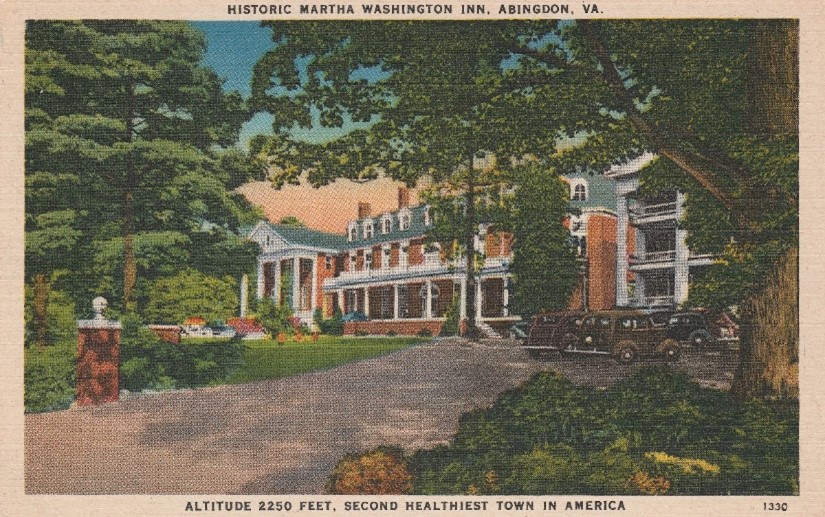
In 1935, the Martha Washington Inn opened in the heart of historic Abingdon. Still in operation today, it has a long and distinguished history.
The brick mansion was built in 1832 by General Francis Preston and his wife, Sarah Buchanan Preston. General Preston, a hero of the War of 1812, needed a large home for his nine children.
In 1858, the house was sold and became the main building of Martha Washington College. Established by the Methodist Church, the college served genteel women until it closed in 1931 due to the Great Depression. During the Civil War, the college building served as a makeshift hospital for wounded and dying Confederate soldiers. Several students from the college served as nurses.
The hotel underwent an $8 million renovation in 1984 that maintained the building’s historic and architectural integrity. Today it operates as the Martha Washington Inn and Spa and has 49 rooms and 14 suites. The hotel’s lobby is the Preston’s former living room. As a throwback to its past, guests can enjoy a complimentary glass of port in the library before turning in for the night. Many guests have reported encounters with Civil War era ghosts during their stay.
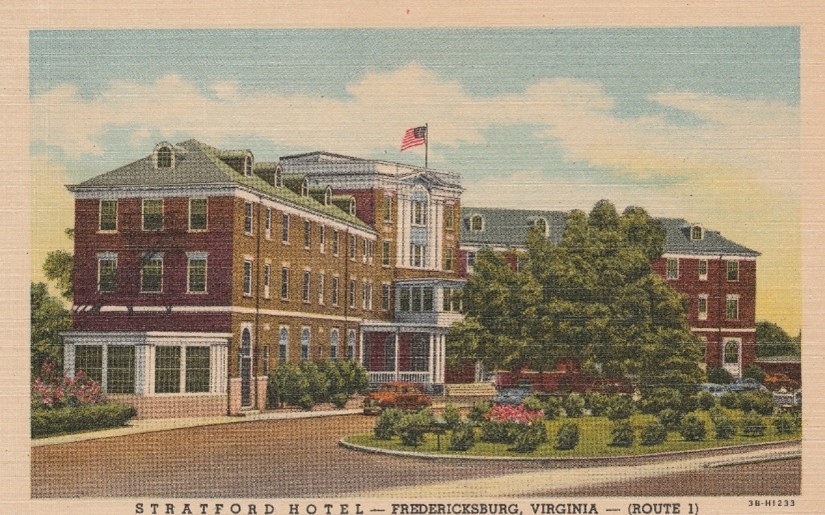
Located on Route 1, then the major North – South artery on the East Coast, the Stratford Hotel in Fredericksburg, Virginia, opened on May 10, 1932. Reportedly, it was built on a site that was the home of George Washington’s Aunt Mildred, who was also his godmother. Washington’s mother, Mary resided a few blocks from the site of the inn. After a change in ownership in 1955, it was renamed the General Washington Inn to capitalize on the connection to our first president. The inn boasted, “George Washington really did sleep here.” The General Washington Inn was renowned for its Colonial Room restaurant. Later a motel annex was added.
The Stratford began a slow decline after the Route 1 bypass opened in 1946 and diverted traffic from the center of Fredericksburg. During the 1960s the hotel further declined as I-95 opened, and new motels were built near its exits. After another ownership change in the early 1970s it became a boarding/apartment house with sparse occupancy. A disco operated in the basement in the late 1970s and in the mid-1980s, the inn was converted to the General Washington Executive Center housing a variety of offices.
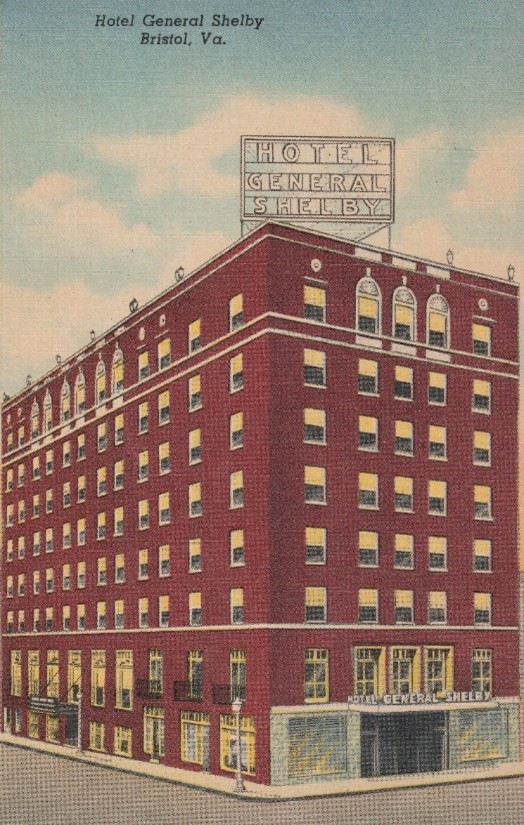
The General Shelby Hotel was located in downtown Bristol. Completed in 1927, it was named for a Revolutionary War hero, General Evan Shelby. The hotel was an impressive 200-room, eight-story hotel that proclaimed it was the “Largest and Best New and Modern Hotel in Bristol.” Not too subtly, the postcard indicates that the General Shelby was the only fireproof hotel in Bristol. It had a coffee shop and an excellent dining room.
Located across from the train station, many of the guests arrived by train in the hotel’s early years. Business declined as railroad passenger traffic declined and highways diverted travelers away from the center of the city. It closed its doors and was demolished in March 1967.
The boundary between Virginia and Tennessee runs through the center of Bristol similar to the boundary between Texas and Arkansas that runs through Texarkana.
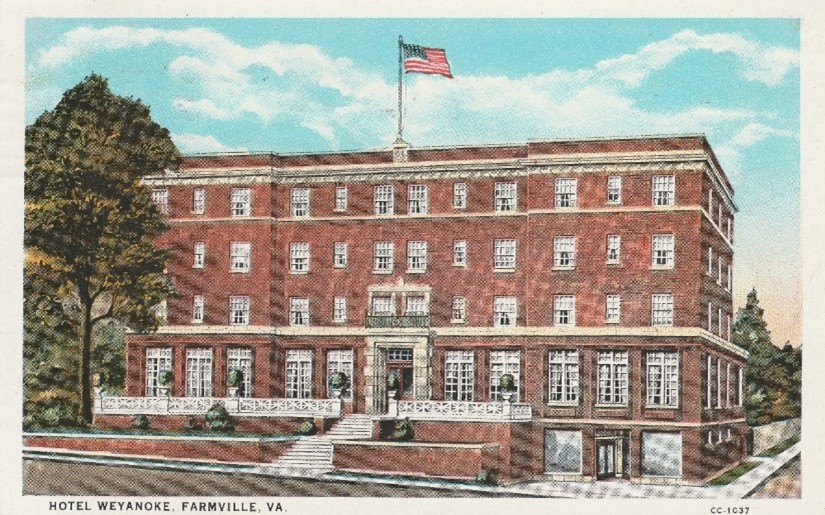
The Hotel Weyanoke in Farmville, Virginia opened in 1925. Unlike many small-town hotels, the Weyanoke is still in operation. This postcard, mailed in 1931, shows the hotel when it opened. The caption proclaims that Farmville’s newest hotel is fireproof and modern in every particular! The hotel is named for the Weyanoke Native-American tribe that lived along the James River.
Today the Weyanoke offers a rooftop bar that did not operate during Prohibition. At the time the postcard was sent, the population of Farmville was 3,133, today it has more than doubled. Farmville is also the home of the Hampden Sydney College (one of the few remaining men’s colleges in the United States) and Longwood University (in 1931, it was a State Teachers College and had all female student body). The presence of the two colleges has contributed to Weyanoke’s continued prosperity.
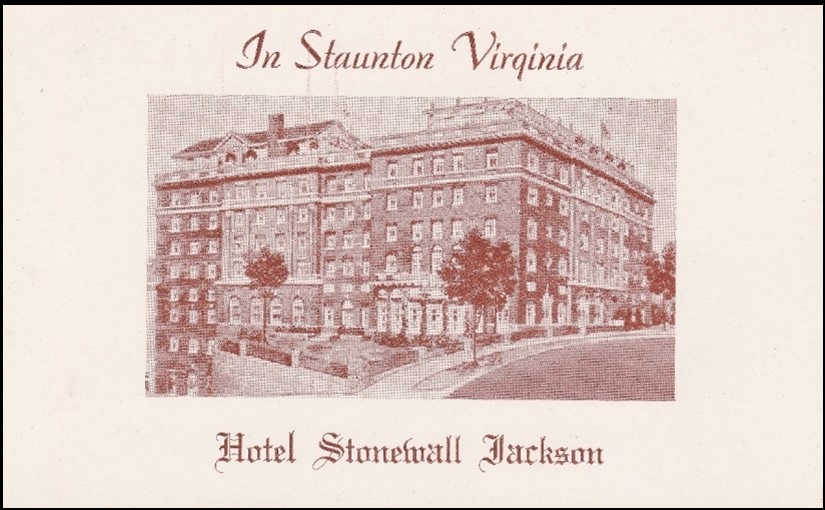
The Hotel Stonewall Jackson in Staunton was built by hotelier Alexander Tobie Moore and opened in May 1924. Five stories tall, the Georgian Revival building had approximately 100 rooms.
A New York architectural firm designed it to meet the expectations of well-heeled travelers of the 1920s. The hotel featured a two-story lobby, the luxurious Fountain Dining Room with crystal chandeliers, and a ballroom.
A Wurlitzer organ was located on the mezzanine. It was a block off Route 11, then a major North – South corridor through the Shenendoah mountains.
Like many hotels, it faced tough times during the Depression and a planned addition was never built. During the 1950s a large neon sign with the hotel’s name was erected on the roof to attract motorists. In the 1960s, I-81 diverted traffic from the center of Staunton and the Stonewall Jackson was forced to close its doors in 1968. It sat vacant for over thirty years. In 2003, $19.3 million restoration of the hotel began, and an addition was constructed containing a conference center with ten meeting rooms. The lobby, ballroom, and dining room were restored to their original elegance and the hotel now has 124 rooms. It retained the Stonewall Jackson name until 2020 when it was renamed the Hotel 24 South.
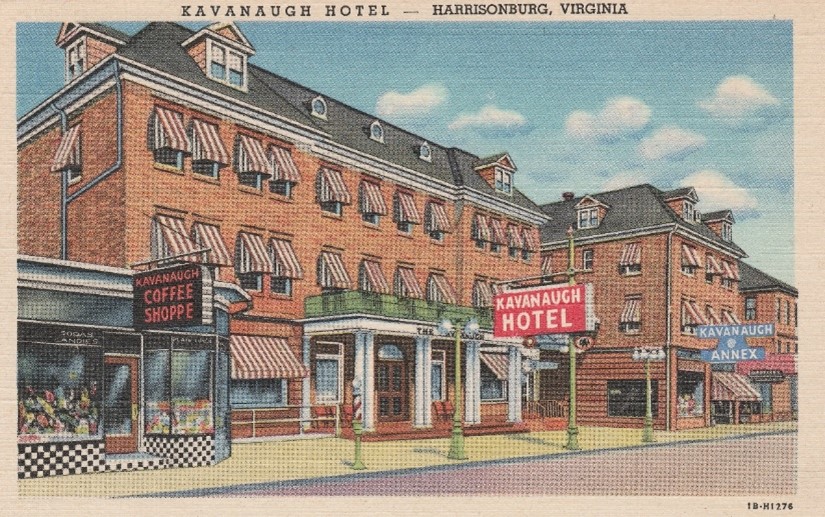
The Kavanaugh Hotel in Harrisonburg was built in 1905 by brothers James and Joseph Kavanaugh. Their father had owned the Virginia Hotel since 1859, which was torn down to make way for the modern building.
Originally the Kavanaugh had 53 rooms. Expansions in 1912 and the early 1920s added 64 more rooms.
The Kavanaugh offered a restaurant, coffee shop, barber shop, and a parking garage. Located on North Main Street (Route 11), the Kavanaugh was known for its Southern cooking. Before Prohibition, the Kavanaugh had a bar that served its own brand of whiskey. The Kavanaugh catered to business travelers as well as motorists traveling on Route 11.
Interstate 81 supplanted Route 11 in the 1960s taking traffic more than a mile to the east of Harrisonburg. In 1977, the Kavanaugh closed, and several years later, the original building was razed. The Harrisonburg Public Safety Building now stands on the site of the original hotel. The 1912 annex was converted in 2021 to a 23-unit apartment house called Kavanaugh Flats & Lofts.
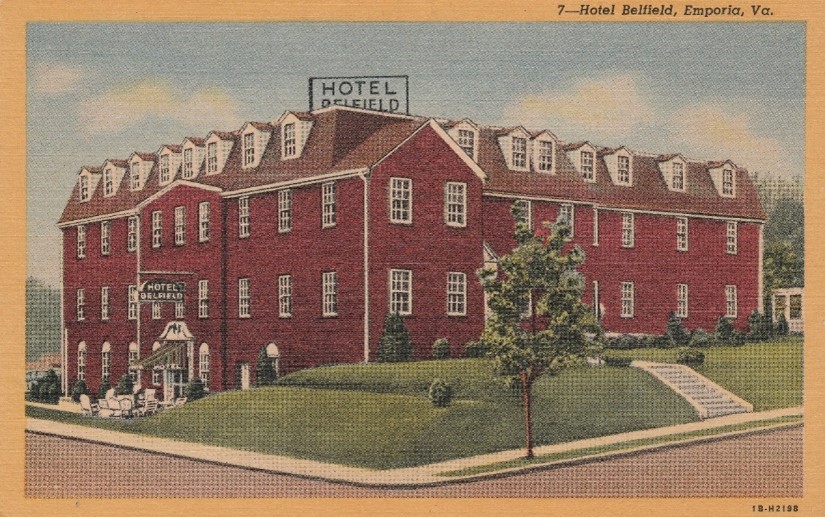
North – South US Route 301 and East-West US Route 58 intersect just north of the North Carolina border in Emporia, Virginia. It was natural that a hotel be erected to serve travelers even though Emporia was a rather small city with a population of only 2,735 in 1940. The Hotel Belfield was built in 1936 on Route 301 (Main Street), a few blocks south of Route 58.
In the early 1960s, one of the first stretches of I-95 built in Virginia (outside Richmond and Northern Virginia) bypassed Emporia and today several motels, fast food restaurants, and gas stations are clustered around the exit from I-95 where it intersects Route 58 just north of Emporia.
Another exit is south of Emporia. Route 58 was also relocated and bypasses the city. These road relocations caused a decline in the Belfield’s business, and it closed in the late 1960s. After it ceased operating as a hotel, it became an apartment house. It is still standing but in disrepair.
The Martha Washington Inn card makes me wonder what town was healthier than Abingdon, and what criteria were used in arriving at the rankings.
Very interesting article! I too like these classic hotels of the early 20th Century. It’s encouraging to see that many have been preserved, even if dedicated to an alternate use.
Very interesting details about each hotel and it’s present use. it’s sad that the interstate roadway system doomed some of these city landmarks.
Interesting article. I’ve stayed at several historic hotels during my travels. Most have been renovated to provide a more modern guest experience. (Most U.S. travelers expect a bathroom to be included in their room.) On a few occasions (e.g. the Wawona Hotel in Yosemite National Park) I immersed myself in a true early-20th Century hotel experience. The downside is waking up at 3:00 a.m. on a brisk Sierra Mountain morning and contemplating the need to dress and go outside to use the facilities. I think it is great that at least some of the hotels mentioned in the article remain,… Read more »
Dan’s articles are always so interesting to read. His comprehensive derails of the subject really make the postcards “come alive”.
Great article! I love the renovated hotels…so much wonderful history and ambiance. Very interesting to see how the interstates and traffic patterns influenced the fate of many of these hotels.
Very interesting and educational article. Most of them were built to last so it’s always nice to hear the buildings remain in use today. Hotels are part of my collection. I enjoy looking at the various architectural styles.